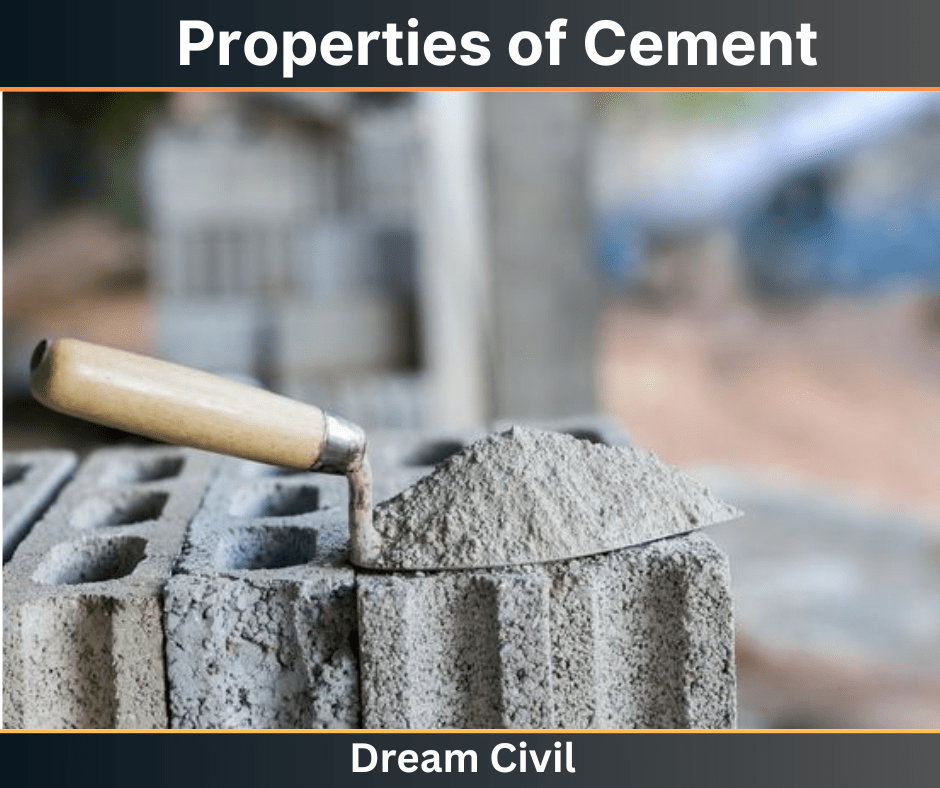Table of Contents
Cement may be prescribed as a material with adhesive and cohesive properties, which make it capable of bonding mineral fragments into a compact whole.
We will discuss the properties of cement in this article.
Cement is the composition of the following:
| Ingredient | Percentage in cement |
| Lime | 60-65 |
| Silica | 17-25 |
| Alumina | 3-8 |
| Magnesia | 1-3 |
| Iron oxide | 0.5-6 |
| Calcium Sulfate | 0.1-0.5 |
| Sulfur Trioxide | 1-3 |
| Alkaline | 0-1 |
The durability and strength of cement depend upon the components present in it.
1. Properties of Cement
The properties of cement can be categorized into two types, namely physical properties & chemical properties.
A. Physical Properties of Cement
1. Fineness
It is the biggest factor in the strength of cement. Higher fineness leads to higher strength.
Higher fineness denotes more area for cement-water reaction increasing strength.
Fineness in cement is achieved by grinding the clinker during the process of production.
2. Soundness
The capacity of not changing of properties of the material, like volume change; when water is added to it, is soundness.
Material with high soundness has a higher strength. So cement should also have high soundness.
Cement should be the cause of high soundness in mortar and concrete.
A few reasons for unsoundness are :
1. Excessive use of Gypsum in cement.
2. Excess of Lime
3. Burned Less
4. Excessive magnesia content
Some of the tests carried out to ensure the soundness are:
b. Autoclave Test
3. Consistency
Uniformity in the nature of the material leads to higher consistency. So, cement should have high consistency.
In other words, the flowing ability of cement paste is called consistency.
Vicat Test is carried out to measure the consistency of cement.
4. Setting Time
When water is added to the cement, it hardens and sets.
Setting time may depend upon the uniformity of cement, water-cement ratio, presence of admixtures, etc.
The initial setting time of the cement should not be less, and the final setting time should not be high.
The best initial and final setting time for cement is given as:
Initial Setting Time: 30-45 Minutes
Final Setting Time: Below 10 Hours
5. Heat of hydration
The chemical reaction between cement and water is called the heat of hydration.
When water is added to cement, heat is generated. This can affect cement quality because excessive hydration leads to undesired strength.
Hydration depends upon the water-cement ratio, uniformness, temperature of curing, etc.
The heat of hydration is mainly affected by C3S and C3A.
6. Strength of Cement
Compressive, tensile, and flexural strength plays a vital role in the durability and quality of cement.
Factors affecting the strength of cement are:
a. Water-cement ratio of a mix.
b. Cement-fine aggregate ratio
c. Curing conditions
d. Size and shape of a specimen
e. The manner of molding and mixing
f. Loading conditions
g. Age of cement
7. Compressibility
Cement has high compressive strength. Thus, it provides stability and durability to the structure.
B. Chemical Properties of Cement
a. Lime
If the lime is used more than 65 %, it may result in the problem of expansion.
b. Alumina
Excess use of alumina quickens the setting time but weakens the cement bonding.
c. Sulfur Trioxide
If more Sulfur Trioxide is used, the cement becomes unsound.
d. Iron oxide
It is also called Ferric Oxide. It is responsible for the color of the cement.
e. Silica
Silica provides high compressive strength, abrasion resistance, and bond strength to cement.
f. Alkaline
The high amount of alkali use leads to difficulty in the regulation of setting time, and the low amount leads to discoloration of cement.
g. Magnesia
If the magnesia is used in high amounts, it results in unsoundness and uneconomical.
Read Also: Parapet Wall | Types of Parapet Wall

